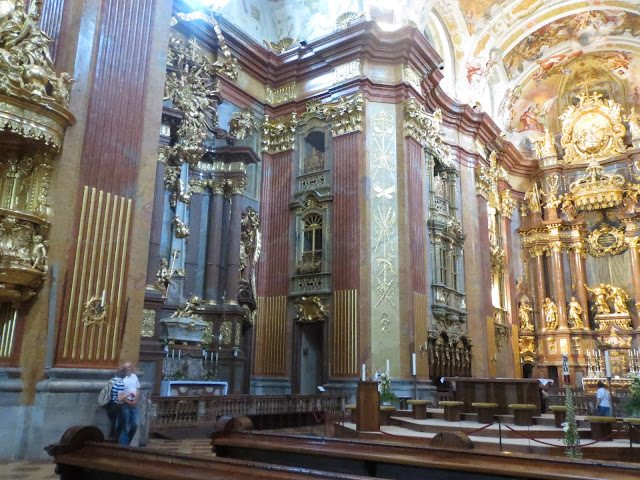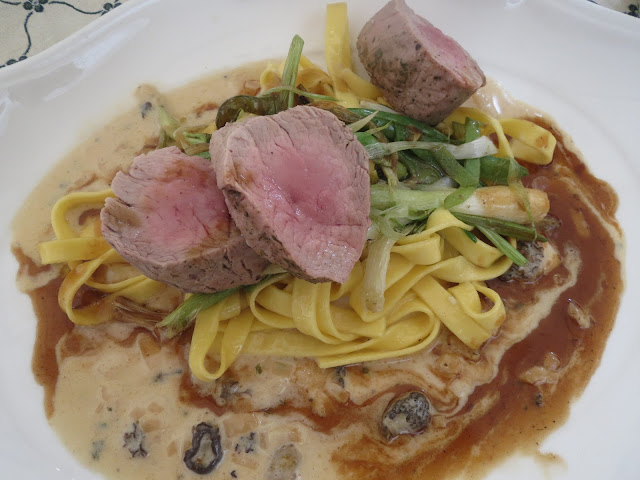As we hurled down the autobahn on our way to Mauthausen, we passed the town of Melk. Melk is a Austrian city located on the Danube.
We could see a large building on the hillside as we zoomed by, and it looked interesting enough to take a second look. Judy pulled out her Rick Steves' Vienna and he highly endorsed a visit to this beautiful town. Those Steves travel books are fabulous and I'll never leave home without them again.
The star attraction of Melk is the Stift Melk, or Melk Abbey. It's a monastery, founded in 1089 by Benedictine monks. The Abbey is actually a castle donated by Leopold II.
The abbey is set on a bluff, easily seen from anywhere in the city, as well as the autobahn.
I've always thought of monastery as gray, sterile, and plain. All those vows of poverty and such. I was about to be surprised.
The original abbey was destroyed by fire in 1297.
The building there today was rebuilt in 1702 through 1736.
Note the two figures beneath the clock-what do you suppose they illustrate? They made me think of Mauthausen.
As Bob and Stan climbed the stairs into the beautiful abbey, I could not help but flash back to those terrible quarry stairs at Mauthausen concentration camp we'd seen just that morning. It is disturbing to think of the abuse and death that happened just down the road while others serenely walked these corridors. I later read that Melk was one of the satellite sites of Mauthasen concentration camp. All through the abbey I found myself thinking of the unbelievable beauty of this place, and contrasting it in my head with the cold, harsh reality of the concentration camp.
The first area we saw was a kind of museum with religious art and religious artifacts.
This is the St. Coloman Monstrance, created in 1752. It contains silver, turquoise, amethyst, diamonds, ivory, garnets, and topaz. It is a religious relic, intended to honor the attributes of St. Coloman. This isn't actually the monstrance, but a sort of hologram-hard to tell just looking at it. The real monstrance is too valuable to risk putting on display.
This crucifix is probably from Vienna, circa 1200. The placard notes that the facial expression is one of deliverance, as opposed to suffering, conveying a sense of calm. Somewhere along the way we learned that crucifixes took an attitude of suffering and agony later--originally they were not made as a figure of suffering, but of serenity and relief.
There were also a lot of panels like this one, painted on wood by Jorg Breu in 1502, depicting the Passion of Christ. It was originally part of an altar on a shrine, which has since been lost.
We saw many of these antique, ornate vestments not only in Melk, but also several other places. This one is 18th century, made of silk and embroidered with gold thread.
As we left the museum, we came through the impressive marble hall, originally the dining room for the castle, now used as a reception hall.
There are beautiful gray and red marble pillars and gold gilding
and a beautiful ceiling fresco "Enlightenment" by Paul Troger in 1731.
The painting style of the fresco makes the ceiling appear to be rounded and three dimensional, although it is not.
Close-up of someone you may wish to avoid.
Window in the hall with view of the room behind it.
The library, where we were not allowed to take pictures, was amazing. This picture is courtesy google images. Melk library contains around 100,000 volumes. Yikes. That may be more books than I will read in my lifetime...
At one time Melk Abbey had a Gutenberg bible. They sold it to Harvard to help pay for renovation of the abbey completed in 1996. Considering what Gutenberg bibles cost, that must have been one doozey of an expensive redo.
A lovely spiral staircase outside of the library.
We had limited time before closing, and we had already experienced the European meaning of "closing time":
If we say we close at 6, we really mean 5:30. If you argue with that, we really mean 5.
We hurried to the church.
If we say we close at 6, we really mean 5:30. If you argue with that, we really mean 5.
We hurried to the church.
I loved the look of this mustard yellow church with white statues of religious figures.
Because of its fame and academic stature, the abbey managed to escape destruction and/or dissolution during wars from 1780-1938.
Peter, holding the keys.
Walking into this church literally took my breath away.
Where do you look? There is SO much to see.
I remember when the Billings temple was built, there was a group of 3 or 4 men and women whose job it was to do the gilding. It was a painstaking job, and it took a lot of time, a steady hand, and a real gift for tedious work. Looking at all the gold gilding in this church, I couldn't help but think of that little team of Billings temple gilders.
The natural light in this church is stunning.
The frescos on the ceilings are the work of Johann Michael Rottmayr
We saw a number of churches, but I think this Baroque cathedral was my favorite.
Judy and I both wondered aloud if Mom had ever been here-for some reason, I just felt sure she had been. Later, Angie and Doris confirmed to us that Mom had taken them there during their 1965 visit.
View of the dome--intended to be a depiction of heaven.
Even the pews were ornate.
The altar of St. Coloman. His remains were brought to Melk in 1045 and since the 18th century they have been in this sarcophagus.
This skeleton is an unknown saint, gifted by Maria Theresia to the Cardinal of the day, and on display since 1792. Now there's a gift you probably wouldn't get in duplicate! We saw skeletons associated with sarcophagi in many churches all over Europe. I also couldn't help but note how often a skull was incorporated into a painting--like a piece of fruit, or the family dog. While we may consider this macabre, apparently it was a respectful and appropriate way to remember a loved one in times gone by.
The Melk Abbey has been used as a school over the years, and is currently home to around 900 students. Bad Ischi clock, made of 10 different woods in 1810. Do you think it was the class workshop project that year?
The abbey had beautiful gardens.
Since the day we visited Melk was Stan's birthday, we stopped at an especially nice restaurant.
I had veal, Judy had deer (right?)
and Stan had Wiener Schnitzel. Best. Food. Ever.
Bob was eating Vegan. This was one of the days I felt sorry he wasn't chowing down on red meat.
As we left the restaurant, the light hit the abbey in a way that was absolutely ethereal.
This day was an amazing day-from concentration camp to abbey. One of the best experiences ever!!

















































Nice post, Chris. You guys did get the best of the bargain for dinner. I think that dinner made Stan a true believer in Wiener Schnitzel.
ReplyDeleteI especially like the POSE of that skeleton--kind of a Marilyn Monroe look. This was a beautiful little town.
ReplyDelete